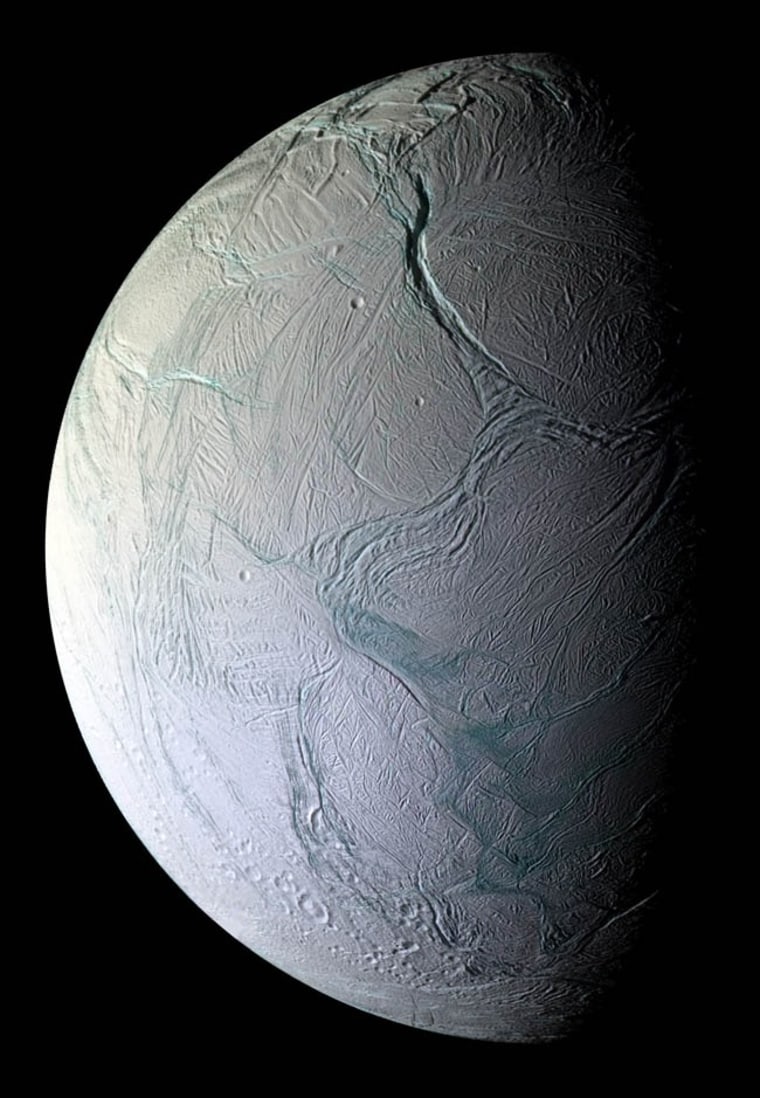The icy crust of Saturn's moon Enceladus appears to occasionally belch up blobs of warm ice, findings that help explain the mysterious heat seen there, scientists now suggest.
NASA's Cassini spacecraft "appears to have caught Enceladus in the middle of a burp," said researcher Francis Nimmo, a planetary scientist at the University of California, Santa Cruz.
Roughly four years ago, Cassini detected heat flow by the moon's south polar region equal to some six gigawatts, the equivalent of at least a dozen electric power plants and at least three times as much heat as an average region of Earth of similar size would produce.
The region was also later seen to swiftly expel the element argon, in gas form, which comes from rocks decaying radioactively and has a well-known rate of decay. Calculations suggested it would be impossible for Enceladus to continually produce heat and gas at this rate.
The south polar region of this moon was puzzling in other ways as well. Although heavily cratered plains in the moon's northern part appear to be as old as 4.2 billion years, and a region near the equator known as Sarandib Planitia is between 3.7 billion and 170 million years old, the south polar area appears to be less than 100 million years old, possibly as young as 500,000 years.
Now researchers suggest the answers behind the mysterious heat, argon and youth seen in the southern part of Enceladus could come from deep inside the moon.
Their computer model of Enceladus, adapted from one of Earth's crust, showed that heat building up from the interior of the Saturnian moon could periodically be released in blobs of warm, light ice rising to the surface, akin to the rising blobs of heated wax in a lava lamp. The rise of the warm blobs would drive cold, heavier ice down into the interior, continuously renewing the surface.
Keep in mind that "warm" is relative. Nimmo said the blobs are probably just below freezing, which is 32 degrees Fahrenheit, whereas the surface is a frigid -316 degrees Fahrenheit.
The computer model suggests the churning periods last some 10 million years, while the quiet times when the surface ice is undisturbed last about 100 million to two billion years. These rare phases make up only about 1 to 10 percent of Enceladus' time.
"These tumultuous periods are rare and Cassini happens to have been watching the moon during one of these special epochs," Nimmo said. He noted that searching Enceladus for areas where ice is converging or splitting apart could shed light on where rising and sinking currents are.
This new model "helps to solve one of the most perplexing mysteries of Enceladus," said Cassini project scientist Bob Pappalardo. "Why is the south polar surface so young? How could this amount of heat be pumped out at the moon's south pole? This idea assembles the pieces of the puzzle."
The argon that Cassini detected would also come up in these tumultuous periods. "If the argon was continuously coming out, it would all be used up in a few tens of millions of years, but it only comes out every so often, switching off and building up and then coming out again," Nimmo explained.
"It's not a coincidence this is happening at the south pole of Enceladus," Nimmo told Space.com. "If you have hot blobs of rising ice, that will actually help tilt the satellite over."
The fact that Enceladus would pretty much look dead out of these burping periods "raises the question of whether something similar might happen someplace else in the solar system that looks dead too," Nimmo said. "There are bodies that do have surfaces of different ages, so maybe they also have this episodic behavior."
Nimmo and geodynamicist Craig O'Neill of Macquarie University in Sydney, Australia, detailed their findings in the Jan. 10 issue of the journal Nature Geoscience.
